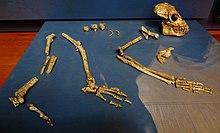Proconsul nyanzae
Ekembo nyanzae, originally classed as a species of Proconsul, is a species of fossil primate first discovered by Louis Leakey on Rusinga Island in 1942, which he published in Nature in 1943. It is also known by the name Dryopithecus africanus. A joint publication of Wilfrid Le Gros Clark and Louis Leakey in 1951, "The Miocene Hominoidea of East Africa", first defines Proconsul nyanzae. In 1965 Simons and Pilbeam replaced Proconsul with Dryopithecus, using the same species names.[1]
| Ekembo nyanzae | |
|---|---|
 | |
| Scientific classification | |
| Kingdom: | Animalia |
| Phylum: | Chordata |
| Class: | Mammalia |
| Order: | Primates |
| Suborder: | Haplorhini |
| Infraorder: | Simiiformes |
| Genus: | †Ekembo |
| Species: | †E. nyanzae |
| Binomial name | |
| †Ekembo nyanzae Le Gros Clark & Leakey, 1950 | |
In 1967, Louis defined Kenyapithecus africanus on seven fossils from Rusinga Island. He saw it as an ancestor of wickeri and also of man, with a date of 20 mya in the middle Miocene. Another fossil found by the VanCouverings on Rusinga in 1967 seemed to confirm africanus. In 1969 Simons and Pilbeam moved Kenyapithecus africanus into Dryopithecus nyanzae. By 1978 the genus had recovered from the Dryopithecine event and was back to Proconsul. In that year Andrews moved Clark & Leakey's 1951 Sivapithecus africanus into Proconsul nyanzae. In 2015, it was moved into the new genus Ekembo.[2]
A more recent discovery by Ward et al. in 1999 [3] and reclassification splits Kenyapithecus africanus away again and lumps it with Equatorius africanus, which would move it to the subfamily Afropithecinae with Afropithecus turkanensis. As Ekembo, Kenyapithecus may not be in the same clade as apes and humans, but as the older Equatorius, it may be.
Morphology
Ekembo nyanzae had a dental formula of 2:1:2:3 on both the upper and lower jaw. The upper premolars of E. nyanzae were large. This species had a relatively thick enamel on the molars. The mandible of this species was relatively robust. E. nyanzae had an average body mass of about 30.0 kilograms.
Range
E. nyanzae lived on the continent of Africa and the fossils were found in areas that suggest it lived in a dry, open woodland environment.
See also
- Chororapithecus
- Dryopithecus
- Human timeline
- Life timeline
- Nakalipithecus
- Pierolapithecus
- Samburupithecus
References
- A now amusing anecdote is told of Louis' reaction to this change by Virginia Morell, "Ancestral Passions", Chapter 21. Louis attended a presentation by the young David Pilbeam, then a graduate student, in Chicago in 1965. Louis interrupted by yelling at Pilbeam to "shut up", among other words. Not finding any support among his mentors and supporters, Pilbeam told Louis to shut up and went on with the presentation. This event is said to have assisted his career.
- Kieran P. McNulty, David R. Begun, Jay Kelley, Fredrick K. Manthi and Emma N. Mbua (2015). "A systematic revision of Proconsul with the description of a new genus of early Miocene hominoid". Journal of Human Evolution. 84: 42-61. doi:10.1016/j.jhevol.2015.03.009.
- S. Ward; B. Brown; A. Hill; J. Kelley; W. Downs (1999). "Equatorius: A New Hominoid Genus from the Middle Miocene of Kenya". Science. 285 (5432): 1382–1386. doi:10.1126/science.285.5432.1382. PMID 10464093.
External links
- The History Files: Hominid Chronology
- http://members.tripod.com/cacajao/equatorius_africanus.html
- Proconsulidae, Mikko's Phylogeny archive
- Proconsul nyanzae, classification in the Taxonomicon site
- Ward CV (November 1993). "Torso morphology and locomotion in Proconsul nyanzae". Am. J. Phys. Anthropol. 92 (3): 291–328. doi:10.1002/ajpa.1330920306. PMID 8291620.
- Partial skeleton of Proconsul nyanzae from Mfangano Island, Kenya, abstract of article by CV Ward in American Journal of Physical Anthropology, Volume 90, Issue 1, Pages 77 – 111, shown on Wiley Interscience site.